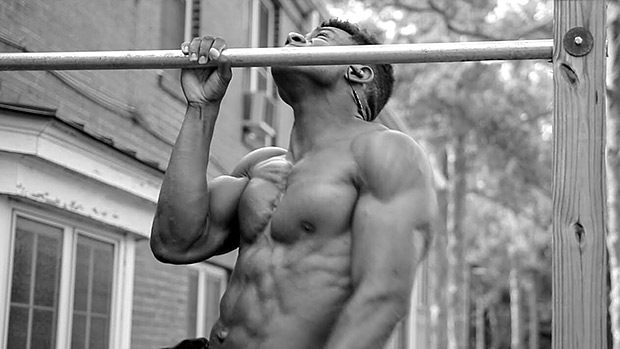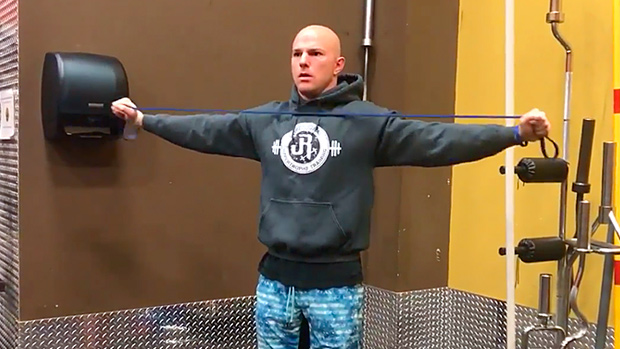One-arm pull-ups are awesome... and difficult. They're even tough for people who can crank out standard pull-ups with good form. And that includes me. I didn't even get close during my first attempt.
So I decided to challenge myself: Try to hit a halfway decent one-arm pull-up in just four weeks. Here's what I learned.
Pick the Right Tool
Your best bet is to use rings instead of a straight bar. Rings allow you to naturally move your shoulder through its normal motion without being put into a "fixed" position. You're more likely to achieve full extension of the arm, get better lat activation, and not destroy your shoulder in the process.
Also, you'll be more successful because you can get more torque involved in your pull. By "torque" I mean the twisting motion when you begin with your palms in a pronated (palms facing away) position, and turn into a supine (palms facing towards you) position.
This will maximize lat activation as well as the amount of help you get from your big elbow flexors such as the biceps, brachialis, and brachioradialis. The downside of rings? You won't have as much control over your body twisting.
Now, keep in mind that learning the one-arm pull-up isn't always a pretty process. Here's what my first few reps looks like:
No, my form wasn't great, but after four weeks I was able to go from a half-rep to two "okay" reps. Give me another month and I'll be able to knock out a few pretty reps that look effortless.
Want to join me in this challenge? Here's what you need to know.
Prerequisite Strength Guidelines
- You should be able to rep off at least 15 solid pull-ups with full extension on the rings before you think about attempting the one-arm pull-up. If you can't do this yet, do 50 pull-ups every time you're at the gym. These 50 pull-ups do not and should not be performed in a row. Take your time with this and take as long as you need to do 50 reps, but don't leave the gym until you're finished. You should do this no fewer than three times per week.
- You should be able to do an assisted one-arm pull-up: one arm on the ring, one arm on the strap to provide assistance. This movement teaches you how to engage your core and pull your body in tight towards the rings. This will allow you to get a feel for the one-arm technique.
- Be able to do controlled a single-arm eccentric or negative pull-up. Do the assisted one-arm pull-up shown earlier, but lower yourself down with control using only one arm.
The Program
Days 1 and 3
| Exercise | Sets | Reps | |
| A | Weighted Pull-Up from Bar | 5 | 5 |
| B | Single-Arm Eccentric Pull-Up | 3 | 3/arm |
| C | Assisted One-Arm Pull-Up | 4 | 3/arm |
| D1 | Chest-Supported Row | 4 | 10 |
| D2 | Hammer Curl | 4 | 10 |
| E1 | Lat Pulldown | 4 | 10 |
| E2 | Reverse Curl | 4 | 10 |
| F1 | Landmine Twist (core movement) | 3 | 10 |
| F2 | Chest Supported Plate I's, Y's, T's | 3 | 12 |
Make sure you do plenty of soft tissue work on your forearms so your elbows aren't screaming at you the next day.
Chest-supported plate I's, Y's, and T's are performed as prehab for the shoulder. You'll want to have a strong rotator cuff to help stabilize the shoulder.
Days 2 and 4
| Exercise | Sets | Reps | |
| A | Heavy Lat Pulldown | 5 | 5 |
| B | Assisted One-Arm Pull-Up | 4 | 5/arm |
| C1 | One-Arm Chest Supported Row | 4 | 5/arm |
| C2 | Bicep Curl | 4 | 5 |
| D1 | One-Arm Lat Pulldown | 4 | 5/arm |
| D2 | One-Arm Hammer Curl | 4 | 5/arm |
| E1 | Dragon Flag (Controlled) | 3 | 3 |
| E2 | Chest-Supported Plate I's, Y's, T's | 3 | 12 |
Note: Dragon flags require advanced core stability. Being able to keep your core as tight as possible is key to getting your first one-arm pull-up.
This program has you alternate workouts every other day. Here's one way to structure it:
Week 1
- Monday: Day 1
- Wednesday: Day 2
- Friday: Day 1
- Sunday: Day 2
Week 2
- Tuesday: Day 1
- Thursday: Day 2
- Saturday: Day 1
Week 3
- Monday: Day 1
- Wednesday: Day 2
- Friday: Day 1
- Sunday: Day 2
Week 4
- Tuesday: Day 1
- Thursday: Day 2
- Saturday: Day 1





